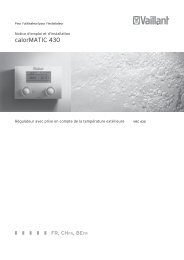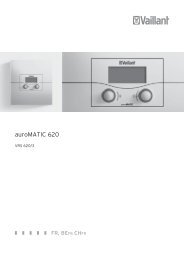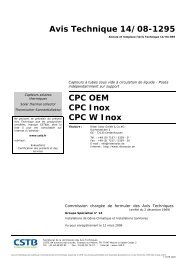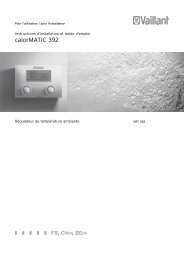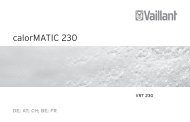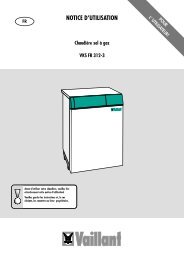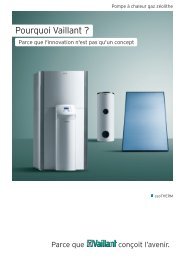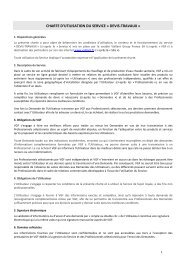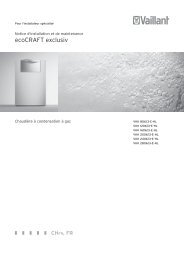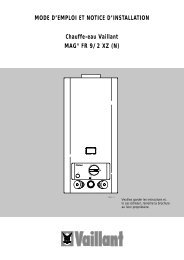vrc 410 bedienungs- und montageanleitung operating and ... - Vaillant
vrc 410 bedienungs- und montageanleitung operating and ... - Vaillant
vrc 410 bedienungs- und montageanleitung operating and ... - Vaillant
- No tags were found...
Create successful ePaper yourself
Turn your PDF publications into a flip-book with our unique Google optimized e-Paper software.
DE GB FR<br />
☞ Vor dem Befestigen des DCF-Empfängers<br />
an der Gebäudew<strong>and</strong> sollte immer<br />
geprüft werden, ob an der<br />
vorgesehenen Stelle auch ein<br />
ausreichend guter Empfang des Zeit-<br />
Signales möglich ist.<br />
☞ Eine Kontrolle ist möglich, wenn eine<br />
provisorische Verdrahtung des DCF-<br />
Empfängers mit dem Heizungsregelgerät<br />
ausgeführt wurde.<br />
☞ In diesem Falle erfolgt eine Anzeige<br />
am Regelgerät wie folgt:<br />
- bei einw<strong>and</strong>freiem Empfang ist der<br />
Sek<strong>und</strong>enpunkt nach ca. 5 min.<br />
blinkend.<br />
- bei Empfangsstörungen<br />
permanenter Sek<strong>und</strong>enpunkt.<br />
Für die optimale Erfassung der Außentemperatur<br />
sollte das Gerät bei Gebäuden<br />
bis zu 3 Geschossen in ungefähr<br />
2/3 Fassadenhöhe angebracht werden.<br />
Bei höheren Gebäuden ist die Anbringung<br />
zwischen dem 2. <strong>und</strong> 3. Geschoß<br />
zu empfehlen.<br />
Der Anbringungsort sollte weder windgeschützt,<br />
noch besonders zugig gelegen<br />
<strong>und</strong> nicht der direkten Sonnenbestrahlung<br />
ausgesetzt sein. Von Öffnungen in der<br />
Außenw<strong>and</strong>, aus denen ständig oder<br />
zeitweise Warmluft strömen kann, muß<br />
das Gerät mindestens 1 m Abst<strong>and</strong><br />
haben.<br />
☞ Before fixing the DCF-receiver to the<br />
wall it should be tested whether<br />
signals can be received to an<br />
adequate st<strong>and</strong>ard.<br />
☞ The signal quality can be checked by<br />
provisionally connecting the<br />
thermostat to the DCF-receiver.<br />
☞ The following display on the<br />
thermostat appears:<br />
- if the signal is received clearly the<br />
second point starts flashing after<br />
approximate 5 min.<br />
- if the signal is faulty the second<br />
point remains permanently.<br />
For the best sensing of outside<br />
temperatures the receiver should be fixed<br />
at a height of approx. 2/3 up from the<br />
floor of a 3 storey building. In case of<br />
higher buildings a position between the<br />
2 nd - 3 rd floor is recommended.<br />
The exact location should not be exposed<br />
to too much or too little wind <strong>and</strong> should<br />
not be in direct sunlight. Should there be<br />
vents in the wall from where any warm<br />
air/products leave the dwelling the<br />
receiver should be positioned in a<br />
distance of at least 1m from the vents.<br />
☞ Avant de fixer le récepteur DCF au<br />
mur du bâtiment, vérifier systématiquement<br />
si la qualité de la réception<br />
du signal d'horloge est suffisante à<br />
l'endroit prévu.<br />
☞ Il est possible d'effectuer un contrôle<br />
si un câblage provisoire reliant le<br />
récepteur DCF au régulateur de<br />
chauffage a été réalisé.<br />
☞ Dans ce cas, l'affichage du régulateur<br />
réagit comme suit:<br />
- En cas de réception impeccable, le<br />
point de seconde clignote au bout<br />
d'environ 5 minutes.<br />
- En cas de perturbation de la réception,<br />
point de seconde permanent.<br />
Pour que la saisie de la température<br />
extérieure soit optimale, l'appareil doit<br />
être placé à environ 2/3 de la hauteur<br />
de la façade si le bâtiment comporte<br />
jusqu'à 3 étages. Si le bâtiment est plus<br />
haut, il est recomm<strong>and</strong>é de placer<br />
l'appareil entre le deuxième et le<br />
troisième étage. L'appareil ne doit pas<br />
être mis en place dans un endroit<br />
particulièrement protégé du vent ni dans<br />
un endroit particulièrement exposé au<br />
vent ; il ne doit pas non être soumis au<br />
rayonnement direct du soleil. Il doit être<br />
installé à au moins 1 m des ouvertures<br />
du mur extérieur dont de l'air chaud peut<br />
s’échapper en permanence ou par<br />
intermittence.<br />
63




